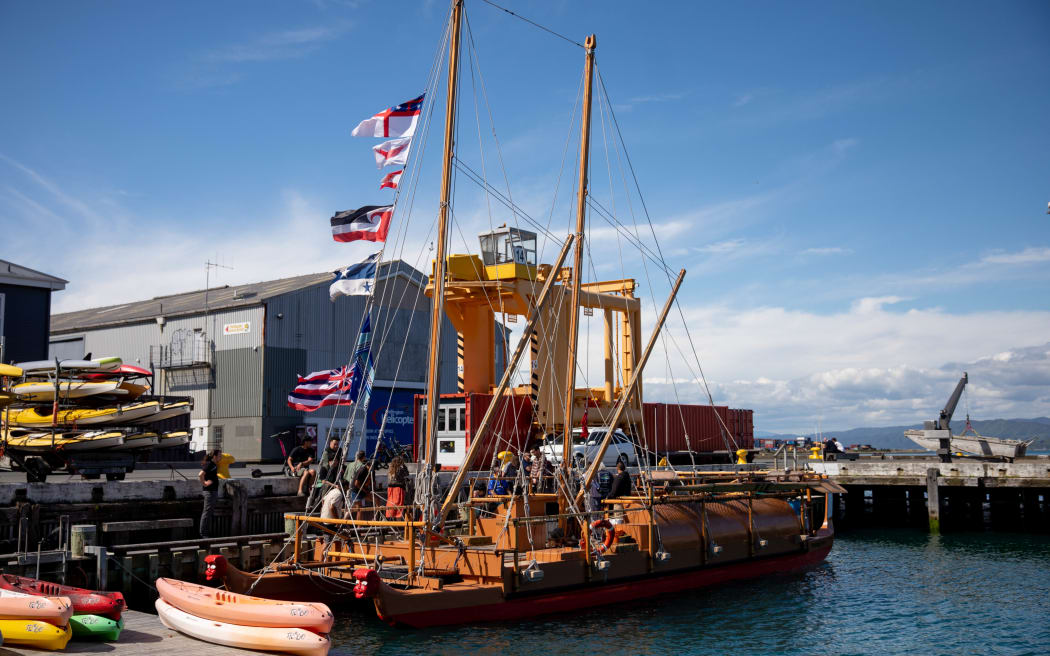Thirty years ago, a crew of rangatahi led by Hekenukumai Busby set sail on a bold voyage of rediscovery to Rarotonga and back, rekindling a knowledge which had been lost, while also proving a point.
They left from Te Tai Tokerau on a double-hulled canoe named Te Aurere, a 60 foot waka hourua made of kauri logs lashed together with a large mast protruding from the centre.
The Aurere voyage followed a wero laid by Sir James Henare in 1985, said the captain of the voyage, Stan Conrad, 30 years after the epic adventure. A similar waka hourua - Hōkūle'a - had arrived from Hawai'i, rebuilt by navigators there.
"That was pretty much the platform for us to carry on," said Conrad. "That kōrero of Pa Henare saying it's the happiest day of his life, against all those critics that said that it was never done."
"That was the platform, but it was also the wero for Hector."
Tā Hek spent years consulting across the Pacific to refine the model of waka hourua he would build.
He then spent time working with tohunga to relearn celestial navigation.
"[The knowledge] was totally lost," said Conrad. "We only could just look at it in books. For all of us it was all new, that was just a small part of what we had to learn."
Combining all of that, Tā Hek then searched across the motu for a crew of rangatahi, who all swore to pass it on themselves.
"If one starts to lack it's going to be hard on the rest of the crew so you've got to make sure that your choice of the crew has got to be the right one," Tā Hek told RNZ in 1992.
Jack Thatcher and Te Aturangi Nepia-Clamp were part of the crew he selected, and they all had something to prove.
Māori were not here by accident, caught in a drift or washed ashore by chance. They followed a mātauranga that saw them purposefully navigate across the greatest ocean in the world.
"I remember when they had the bicentenary of Endeavour arriving in Gisborne in 1969 and I was a school kid at the time," recalled Nepia-Clamp
"At school we were taught that the greatest sailor, the greatest navigator was Cook and our ancestors were nothing but accidental drifters."
"Luckily I got home at night and mum would say, 'oh what did you learn at school today son', and I told her and she'd say, 'no that's not right. You come from a proud line of voyagers'."

Photo: RNZ / Angus Dreaver
So in 1992, they set off on Te Aurere, finding their way using only the stars, the swells and the birds. It was the first waka hourua voyage in centuries, Māori returning to their ancestral roots in Te Moana Nui-a-Kiwa.
They endured rogue waves, nearly being wiped out by a cargo ship, and a four-day cyclone. But they made it.
"You put your trust in your waka and our waka brought us through it," Conrad said. "Pity we broke our mast but we still go through with our waka, our waka brought us home."
And they did it. They sailed to Rarotonga, then back to Aotearoa. As Te Aurere struck the sand in 1992, Hekenukumai Busby told RNZ's Henare Te Ua, "the voyage has proved that they did it and they must have done it."
"We got to Rarotonga and we also got back. We've really proved that the double-hulled canoe can withstand virtually any kind of sea."
Hekenukumai Busby died in 2019. But that was after a life of building many more waka and embarking on many more voyages, completing a triangle that saw him navigate to Hawai'i and Rapa Nui.
On the thirty-year anniversary, Conrad, Thatcher and Nepia-Clamp were all among the original Te Aurere crew who gathered in Wellington this week, on board another of Tā Hek's waka, Ngahiraka Mai Tawhiti.
Three decades on, they all teach waka hourua and navigation to hundreds of rangatahi around the country. And they've set the record straight about what tūpuna were capable of, and did.
"You think about what he's done and what we've done, the three of us alone over those 30 years, we've done a lot," said Conrad.
"When we stepped off in that '92 voyage we just didn't realise where this was going to go to. You look around you now and you see the momentum of our people."
Nepia-Clamp chipped in: "And setting the story straight."


